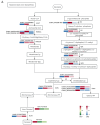Infestation of Rice Striped Stem Borer (Chilo suppressalis) Larvae Induces Emission of Volatile Organic Compounds in Rice and Repels Female Adult Oviposition
- PMID: 39201513
- PMCID: PMC11354779
- DOI: 10.3390/ijms25168827
Infestation of Rice Striped Stem Borer (Chilo suppressalis) Larvae Induces Emission of Volatile Organic Compounds in Rice and Repels Female Adult Oviposition
Abstract
Plants regulate the biosynthesis and emission of metabolic compounds to manage herbivorous stresses. In this study, as a destructive pest, the pre-infestation of rice striped stem borer (SSB, Chilo suppressalis) larvae on rice (Oryza sativa) reduced the subsequent SSB female adult oviposition preference. Widely targeted volatilomics and transcriptome sequencing were used to identify released volatile metabolic profiles and differentially expressed genes in SSB-infested and uninfested rice plants. SSB infestation significantly altered the accumulation of 71 volatile organic compounds (VOCs), including 13 terpenoids. A total of 7897 significantly differentially expressed genes were identified, and genes involved in the terpenoid and phenylpropanoid metabolic pathways were highly enriched. Correlation analysis revealed that DEGs in terpenoid metabolism-related pathways were likely involved in the regulation of VOC biosynthesis in SSB-infested rice plants. Furthermore, two terpenoids, (-)-carvone and cedrol, were selected to analyse the behaviour of SSB and predators. Y-tube olfactometer tests demonstrated that both (-)-carvone and cedrol could repel SSB adults at higher concentrations; (-)-carvone could simultaneously attract the natural enemies of SSB, Cotesia chilonis and Trichogramma japonicum, and cedrol could only attract T. japonicum at lower concentrations. These findings provide a better understanding of the response of rice plants to SSB and contribute to the development of new strategies to control herbivorous pests.
Keywords: plant–insect interactions; rice; rice striped stem borer; transcriptome; volatilomics.
Conflict of interest statement
The authors declare that the research was conducted in the absence of any commercial or financial relationships that could be construed as a potential conflict of interest.
Figures








Similar articles
-
Ferritin From Striped Stem Borer (Chilo suppressalis) Oral Secretion Acts as an Effector Helping to Maintain Iron Homoeostasis and Impair Defenses in Rice.Plant Cell Environ. 2025 May;48(5):3735-3749. doi: 10.1111/pce.15386. Epub 2025 Jan 15. Plant Cell Environ. 2025. PMID: 39812459
-
Integrative transcriptome and metabolome analyses provide insights into rice defence against Chilo suppressalis oviposition.Plant Mol Biol. 2025 Jun 12;115(4):74. doi: 10.1007/s11103-025-01601-w. Plant Mol Biol. 2025. PMID: 40506652
-
Plant Immunity Inducer-Enhanced Volatiles in Rice: Boosting Indirect Defense against Striped Stem Borers Through Parasitoid Attraction.J Agric Food Chem. 2025 Jul 2;73(26):16408-16419. doi: 10.1021/acs.jafc.5c05057. Epub 2025 Jun 20. J Agric Food Chem. 2025. PMID: 40538246
-
Volatolomics to Decrypt the Monophagous Nature of a Rice Pest, Scirpophaga Incertulas (Walker).J Chem Ecol. 2024 Aug;50(7-8):373-384. doi: 10.1007/s10886-024-01498-7. Epub 2024 Apr 19. J Chem Ecol. 2024. PMID: 38637418 Review.
-
Defense Strategies of Rice in Response to the Attack of the Herbivorous Insect, Chilo suppressalis.Int J Mol Sci. 2023 Sep 21;24(18):14361. doi: 10.3390/ijms241814361. Int J Mol Sci. 2023. PMID: 37762665 Free PMC article. Review.
References
MeSH terms
Substances
Grants and funding
LinkOut - more resources
Full Text Sources

